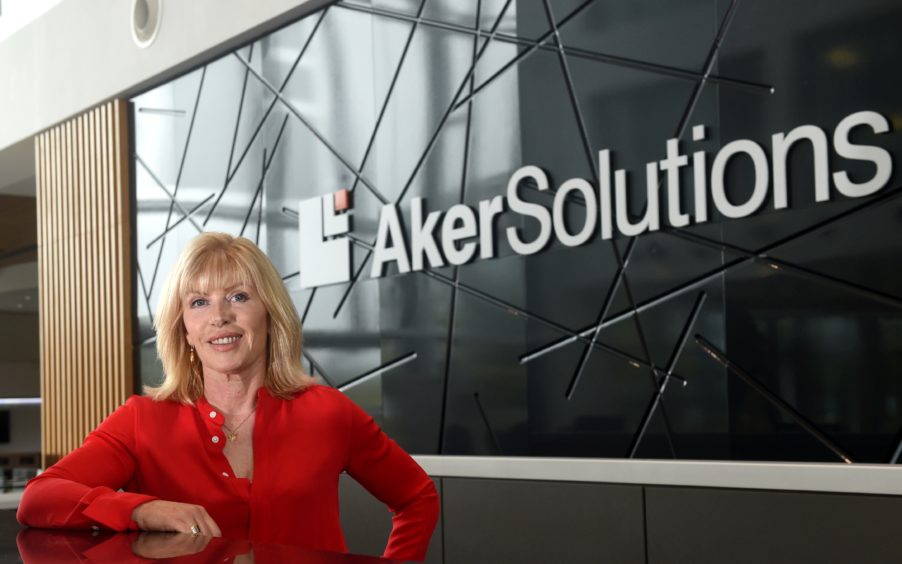
The scale of the challenges posed by the energy transition make tackling it a daunting prospect.
Decarbonising the sector will require one of the biggest structural overhauls in human history, while the additional time pressures are all too apparent.
It’s easy to become overwhelmed but Sian Lloyd Rees, UK country manager at Aker Solutions, is keen to highlight that the skills and innovation in the oil and gas industry make it perfectly placed to deliver the changes needed.
“We’ve faced difficult challenges before, and we’ve solved them. I think it’ll be the same again,” she said.
As was discussed at Energy Voice’s ETIDEX event last year, Aker Solutions’ Norwegian heritage means that it has been engaged in supporting the wider energy industry for many years.
It is now focussed on harnessing its capabilities and using them to support the transition, a mantra that has been adopted by many other supply chain firms.
Lloyd Rees said: “What’s needed now is for us to work together as an industry, look at our proficiencies, our technology and how we adapt them – agility will be key.
“The price points, the requirements and the approaches differ across the energy sector but it’s still essentially learning and building on our years of knowledge and experience.”
Floating structures used today in deep waters and harsh environments offshore are relevant to the growing offshore wind market, while the gas processing management skills that exist in the UK are applicable to the country’s future hydrogen ambition.
Lloyd Rees said: “Aker Solutions has been designing and delivering fixed and floating steel, concrete, semi-sub and cylindrical spar structures to both the wind and oil and gas industry for many years.
“We’re currently executing the EPC contract for Hywind Tampen, the world’s largest project for offshore wind power based on floating installations.
“In addition, we’re currently part of a consortium, led by Iberdrola and called the Flagship Project, developing a 10 megawatt (MW) floating offshore wind turbine and a semi-submersible floating concrete structure. We are also engineering HVDC transmission systems today in the UK. We build on decades of capability and solve new challenges as we go.”
In order to galvanise the supply chain for the low carbon push, transparency and visibility of upcoming projects is key.
“The greater the clarity on the challenges that are facing us in the energy transition, the more capable our highly skilled workforce will be of developing the solutions,” Ms Lloyd Rees said.
She added: “At Aker Solutions, and in my roll on the board of Oil and Gas UK, there’s work ongoing in terms of highlighting the broad capabilities of our supply chain, whilst also establishing and sharing the pipeline of future projects.
“From an Aker Solutions perspective we draw on both our global and local capability for expertise and high value solutions. With a drive towards greater local content in future projects we continually develop our people to adapt into these new industries. It’s always going to be the case that we need to hire new skills, but we’ve got a real focus on developing our current workforce.”
As well as ensuring the energy transition is at the heart of its culture, Aker Solutions is also engaging in several projects that aim to help provide the basis for the future low carbon economy.
The engineering firm, which has a regional base on the outskirts of Aberdeen, is delivering the onshore facilities and subsea equipment for Equinor’s ground-breaking Northern Lights carbon capture and storage (CCS) project.
The company is also the contractor for engineering, procurement and project management assistance for a new carbon capture facility connected to the cement production plant in Brevik, Norway.
In the UK, Aker Solutions is supporting the work being done by NECCUS to deliver a CCS roadmap for Scotland, which is aiming to decarbonise most of the industry north of the border.
Lloyd Rees added: “In the UK it’s really important for us to share our knowledge and work with partners that have complimentary capabilities and track record to ours. We learn from each other and innovate together. That makes the whole supply chain much stronger.”
Recommended for you

